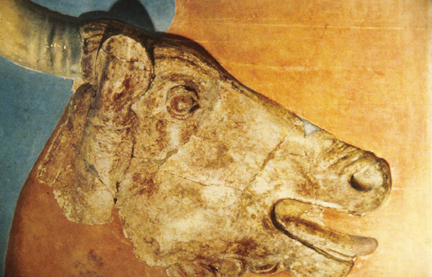
Head of a Bull in relief, Stucco with color, Middle Minoan, 1900-1700 BCE
ART 198 - HISTORY OF WORLD CERAMICS
| This head of a bull, in relief stucco with color, was found in a columned vestibule in the Palace of Knossus on Crete. While not ceramic, it shows the importance of the image of the bull in this culture, where one of the most popular sports was 'bull jumping,' a dangerous activity in which youths would run towards a bull, and grasping its horns, would execute a somersault over it, landing on their feet behind the bull (with any luck). The importance of the image of the bull to the Minoans derives from the myth of the MINOTAUR. Remember that Minos was the king of Crete, and that he was given the gift of a beautiful snow white bull by Poseidon, god of the sea. All that Poseidon asked was that Minos sacrifice the bull in honor of the god. However, Minos thought the bull too beautiful to sacrifice, and decided to keep it alive in his stables. Furious, Poseidon caused Minos' wife Pasiphae to fall in love with the bull, with the inevitable result of a son being born, half man and half bull, the Minotaur of legend. Even though this zoomorphic son was the result of this ill fated union of Poseidon and his own wife, Minos could not bring himself to kill the Minotaur, and instead exiled it to the LABYRINTH, an elaborate maze he had built. Later, another son of Minos named Androgeos (this son all human), was killed in battle with the Athenians, and in a rage, Minos ordered the Athenians to send 7 young warriors and 7 maidens every three years to Crete to be sacrificed to the Minotaur. Upon the third round of sacrifices, the Athenian hero, Thesus, battled and killed the Minotaur, ending the gruesome pilgrimages to the island. | Head of a Bull in relief, Stucco with color, Middle Minoan, 1900-1700 BCE |
|
|